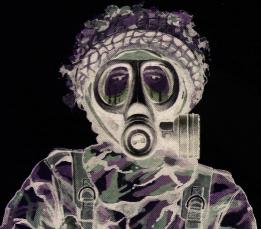•••• THE CHEMICAL AND BIOLOGICAL THREATS ••••

It
is quite reasonable to assume that in an all-out nuclear conflict
chemical and biological weapons will be employed. While chemical weapons
might have a predominant tactical use, i.e., on a battle field, biological
weapons, which are subject to the possibility of some sort of negative
feedback, i.e., changing wind directions carrying them back towards
the offender since they depend on the dispersal in the atmospheric
winds, might be prevalently employed to target populations in distant
areas at intercontinental range.
Following an introductory section concerning these agents of mass
destruction is a resume describing the properties [1]
of known chemical and biological agents, safety precautions, first
aid measures and notes concerning decontamination. Additional related
information will be found also on several plates.
CHEMICAL AND BIOLOGICAL WEAPONS OF MASS DESTRUCTION.
Chemical agents.
The
behavior of chemical agents is dependent on weather variables such as
wind, temperature, air stability, humidity, and precipitation. The influence
of each variable depends upon the synoptic situation and is locally
influenced by topography, vegetation and soil. Chemical agents may be
dispersed in different forms: vapors, aerosols, or liquids. It is hence
important how these agents are affected by environmental constraints
hence following is an overview of the basic characteristics of chemical
agents and the ambience effects.
Basic Characteristics
Vapors and small particles are carried by the winds, while any large
particles and liquids drops fall out in a ballistic-like trajectory
and are quickly deposited on the ground. Many agents give off vapors
that form vapor clouds. The speed at which an agent gives off vapors
is called volatility. Agents may be removed naturally from the air by
falling out(large particles falling to the ground more quickly), by
sticking to the ground or vegetation, or by being removed by precipitation.
Once deposited on vegetation or other ground cover, volatile agents
may be re-released to the atmosphere for further cycles of travel and
present an hazard until sufficiently diluted or decontaminated. During
approximately the first 30 seconds, the size and travel of an agent
are determined primarily by the functioning characteristics of munition
or delivery system. Thereafter, the travel and diffusion of the agent
cloud are determined primarily by weather and terrain. For example,
in high temperatures, volatile agents produce maximum agent vapor in
15 seconds. Light winds and low turbulence allow high local concentrations
of agents, while high winds and strong turbulence reduce the concentration
and increase the area coverage by more quickly carrying away and diffusing
the agent cloud.
Vapors - When a chemical agent is disseminated as a vapor from a bursting munition, initially the cloud expands, grows cooler and heavier, and tends to retain it form. The height of the thermally stabilized cloud is height to which the cloud rises, due to it buoyancy. If the vapor density of the released agent is less than the air's vapor density, the cloud rises quite rapidly, mixes with the surrounding air, and dilutes rapidly. If the agent forms a dense gas, its vapor density being greater than the air's vapor density, the cloud flattens, sinks, and flows aver the earth's surface. Generally, cloud growth during the first 30 seconds is more dependent upon the munition or delivery system than upon surrounding meteorological conditions.